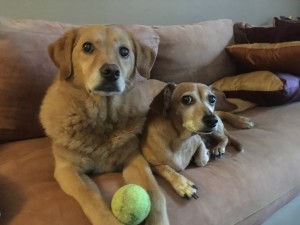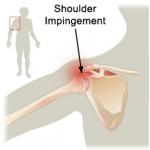Michael Baugh CDBC CPDT-KSA
When I was a child I imagined I could communicate telepathically with my dog, Casper. I wanted to know what he was thinking and what he was trying to say to me, so I imagined it. I spent hours with him and told myself stories about what it all meant. There’s a lot of nostalgia there – a boy and his dog. And, if you’re waiting for a “but,” there isn’t one.
This is what we humans do. We tell stories, all 7.4 billion of us. There isn’t a human being on the planet who doesn’t speak and think in at least one language. We think in words and words are what fill our brains every waking hour and some of our sleeping hours as well. They are powerful things, these wordy thoughts. Powerful good. Powerful bad sometimes, too.
 Even now as adults I know we all still create stories about what our dogs are thinking and what they’re trying to say to us. We’re only human, after all. I wrote a blog a few years ago called Positive Thinking – Positive Training about how our thoughts and stories about our dogs can get in the way of good training. We keep tripping over our brains, crowded with words. My dog is jealous of me – My dog thinks he’s alpha – He’s stubborn or defiant. Then we slip and fall into even worse thinking. I need to show him who’s boss – this is hopeless – I can’t anymore.
Even now as adults I know we all still create stories about what our dogs are thinking and what they’re trying to say to us. We’re only human, after all. I wrote a blog a few years ago called Positive Thinking – Positive Training about how our thoughts and stories about our dogs can get in the way of good training. We keep tripping over our brains, crowded with words. My dog is jealous of me – My dog thinks he’s alpha – He’s stubborn or defiant. Then we slip and fall into even worse thinking. I need to show him who’s boss – this is hopeless – I can’t anymore.
It’s a curse of being human. We can’t always think our way out of problems, but we can almost always think our way into them. In our worst moments our thoughts spiral and loop back on themselves. We become anxious or depressed. We make bad decisions or become too paralyzed to act. Things get worse.
How can we tame our minds and slow down these damaging thoughts? I mentioned Aaron Beck in my Positive Thinking blog post. He’s credited with pioneering Cognitive Behavior Therapy, a great tool for helping us humans to think better about the stories we tell ourselves. I also recommend the writing of Steven Hayes who developed Acceptance Commitment Therapy (ACT), which helps us notice thoughts without struggling against them. The book The Happiness Trap is a great introduction to ACT.
And, none of this is new. Buddhist teachers have been helping folks tame their minds for millennia. Mindfulness is something of a catchword these days but it has a deep history. When we are aware and present (mindful) we can see our brain chatter from a different perspective – almost like we’re an observer. Hmm, I’m having some thoughts. Author and Buddhist nun, Pema Chödrön writes about not getting hooked by those thoughts. We notice them, but we don’t engage them – we don’t get sucked into the spiral or the word loop in our heads. How? Meditation.
What does meditation have to do with dog training? Everything. It’s where we practice patiently and gently settling our own minds. Chödrön and others frequently refer to our “monkey brain” – fast moving thoughts coming at us nonstop. The 8th Century Monk, Shantideva, refers to it as the “elephant mind;” the thoughts are sometimes strong and pressing. When we meditate, we are learning to tame our thinking – the fast moving monkey and the pressing elephant. We acknowledge thoughts but then release them. Thinking. There is it. Off it goes. Breathe. We don’t judge. We simply notice and let them go. We then return our focus to our breathing. You’ve heard about breathing in meditation. It keeps us in the present moment. It’s where we put our attention when we feel like we’re getting hooked by a thought or two – or fifty. I highly recommend Chödrön’s book, How to Meditate, for more information.
Here’s how it relates to our work with our dogs. Meditation sessions are brain training. We learn how to see thoughts, many of them potentially damaging, and then set them aside. We don’t get hooked. We don’t act on them. We return to the breathing and relax into the right-now. Later, though, in our daily lives we can use these same skills. In a teaching session with our dog we might have a thought like, oh he’s never going to be able to do this. But, we don’t have to believe it. We don’t have to become paralyzed by it. We’re not hooked. We can notice the thought and then let it go – returning to the present moment with our dog. Yes, we’ll observe our dog’s behavior. And, yes we’ll adjust the learning session to help him succeed with the task at hand (that’s all thinking of a sort). But with our new clearer minds we won’t be stymied by useless or destructive thoughts.
So often in dog training we talk about starting with our own behavior. Our actions affect the choices our dog’s make. Now we’re taking one extra step back to look not just at our actions but our thoughts. Is our wordy brain chatter leading us to poor choices with our dogs? Or, is our clear thinking helping us both? Let’s see our thoughts for what they are. Let’s tame them. Let’s set the ones aside that we don’t need and come back to the ones we do. Let’s think and act better. And breathe. And simply be. Be human with a delightful brain full of stories. But be present and mindful, too. And most certainly, be right here right now in this moment with your dog.
Michael Baugh teaches dog training in Houston TX. He helps families whose dogs behave aggressively and fearfully.



